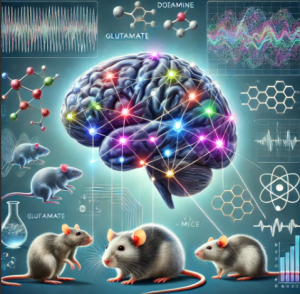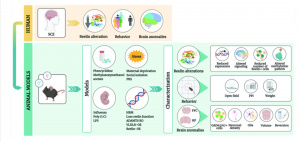
Artstract created by Ren Lind
Schizophrenia is a disorder that can significantly affect a human’s life, but can we mimic the symptoms in rats? How can researchers tell if the rats are experiencing something cognitively, such as hallucinations or delusions? First, let’s dive into Schizophrenia and a theory around its pathology to understand the animal models for this disorder.
Schizophrenia
Schizophrenia is beginning to be understood as a neurodevelopmental disorder. [1] There are positive and negative symptoms. Positive symptoms do not refer to positive as good symptoms, but rather positive symptoms are hallucinations, delusions, and other thought distortions. Negative symptoms are seen as social withdrawal, significant decrease in motivation, and a lack of or excessive movement, to name a few. Cognitive dysfunction is also present in people with Schizophrenia. [2] People with Schizophrenia typically do not present symptoms until late adolescence to middle adulthood.
Researchers Michaud and Pourquié hypothesize that developmental pathways are disrupted in people with Schizophrenia. They specifically refer to the Wnt pathway, a process in the brain that is important for neuron connection development, promoting brain growth during development and adult neural brain circuitry function. With this in mind, let’s consider the common animal models for Schizophrenia.
Animal Models
Researchers can use animal models to study treatment options, pathology, and symptoms for human conditions without using human subjects. Rats are the animal most commonly used for Schizophrenia models. Researchers will modify the rat to induce Schizophrenia-like symptoms.
We can’t ask a rat if it’s experiencing hallucinations or other Schizophrenia symptoms, but their behavior can be analyzed to determine if something is happening. Behaviorally, researchers use various behavioral tests to look at increased anxiety behaviors, deficits in learning and memory, withdrawn social behaviors, and excessive or lack of movement in new environments, among other characteristics. Anatomically, researchers can analyze brain activity and anatomy to determine differences associated with Schizophrenia.
There are four main categories for creating animal models for Schizophrenia: physically modifying neural development, external stress, medication, and altering gene expression. [3]

[4] Figure 1: Overview of Schizophrenia model types, the rat characteristics, and tests for analyzing their behaviors.
Developmentally, researchers put a small cut in the rat’s brain 7 days after it’s born. Another model injects a pregnant rat with Maternal Immune Activation (MIA) to turn on immune responses that are similar to that of human sickness, and the infant rat will be the subject. Both of these models elicit the behaviors mentioned earlier during the rat’s late adolescence to adulthood, which is a similar age range to human development of Schizophrenia.
Because developmental changes can elicit Schizophrenia-like behaviors in a similar age range, it is further evidence that Schizophrenia is a neurodevelopmental disorder.
Inducing post-weaning stress or social isolation will create similar behaviors. Researchers can use a variety of drugs to induce psychosis in rats, but typically, the social behaviors associated with Schizophrenia will not be present in these models. Several risk genes can be expressed or not expressed to induce Schizophrenia in rats and offer promising research opportunities for understanding the genetic background of Schizophrenia.
These animal models are not a “perfect fit” for mimicking Schizophrenia. No animal model can completely portray the nuances of human experience, and many of these behaviors in the rats overlap with other neurodevelopmental model behaviors, however, it is still a valuable research method. There are many gaps in knowledge about Schizophrenia in research, so any progress we can make with the resources we have will help develop efficient therapies, social understanding, and medical resources.
Resources
[1] Michaud, J. L., Pourquié, O. (2013). An emerging role for Wnt and GSK3
signaling pathways in schizophrenia. Clinical Genetics, 83, 511-517. doi: 10.1111/cge.12111
[2, 3] Winship, I. R., Dursun, S. M., Baker, G. B., Balista, P. A., Kandratavicius, L., Maia-de-Oliveira, J. P., Hallak, J., & Howland, J. G. (2019). An Overview of Animal Models Related to Schizophrenia. Canadian journal of psychiatry. Revue canadienne de psychiatrie, 64(1), 5–17. https://doi.org/10.1177/0706743718773728
[4] Sánchez-Hidalgo, Ana & Martín Cuevas, Celia & Crespo-Facorro, Benedicto & Garrido Torres, Nathalia. (2022). Reelin Alterations, Behavioral Phenotypes, and Brain Anomalies in Schizophrenia: A Systematic Review of Insights From Rodent Models. Frontiers in Neuroanatomy. 16. 10.3389/fnana.2022.844737.